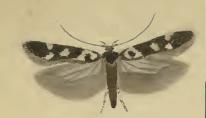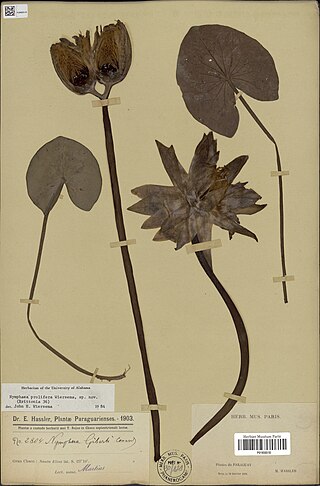
Lomelosia prolifera, the Carmel daisy, is a flowering plant of the family Caprifoliaceae. Its flowers in February to May, are creamy yellow, and when the petals are shed they leave a greenish-looking dried flower, good for arrangements. It is native to the eastern Mediterranean.

Lilla Karlsö is a small Swedish island in the Baltic Sea, situated about 3 km (1.9 mi) off the west coast of Gotland and 4.5 km (2.8 mi) from Stora Karlsö; it is part of Eksta socken. During summer there are tour boats from Djupvik 15 km (9.3 mi) south of Klintehamn.

Azorella is a genus of flowering plants in the family Apiaceae, native to South America, New Zealand, southeastern Australia, and the islands of the Southern Ocean.

Petrorhagia is a small genus of annual and perennial plants of the family Caryophyllaceae, mostly native to the Mediterranean region. It is low-growing with wiry stems and narrow, grass-like leaves. The flowers are small, in clusters similar to members of the genus Dianthus, in pink, lilac, or white. Petrorhagia saxifraga is the tunic flower or coat flower, similar to baby's breath, but shorter, and used in rock gardens.

Drosera adelae, commonly known as the lance-leaved sundew, is a carnivorous plant in the genus Drosera that is endemic to Queensland, Australia.

Woodwardia is a genus of ferns in the family Blechnaceae, in the suborder Aspleniineae of the order Polypodiales. Species are known as netted-chain ferns. The genus is native to warm temperate and subtropical regions of the Northern Hemisphere. They are large ferns, with fronds growing to 50–300 cm long depending on the species. The fossil record of the genus extends to the Paleocene.
Polyscias prolifera, synonym Arthrophyllum proliferum, is a species of plant in the family Araliaceae. It is endemic to Papua New Guinea.

Cylindropuntia prolifera, known by the common name Coastal cholla, is a species of cactus. In Australia it is called 'Jumping Cholla' because of it seeming to jump from outbreak to outbreak.

Petrorhagia dubia is a species of flowering plant in the family Caryophyllaceae known by the common name hairy pink. It is native to southern Europe and the Mediterranean Basin, but it is known on other continents, including Australia and North and South America, as an introduced species and sometimes a weed. It is an annual herb growing 25 to 60 centimeters tall, but known to reach 90 centimeters in height. The leaves are up to 6 centimeters long, sheathing the stem at the bases. The inflorescence bears a head-like cluster of flowers, their bases enclosed in a large, expanded mass of wide, claw-tipped bracts. The flower corollas are each further encased in a tubular calyx of sepals. The petals are bright pink to magenta or lavender in color with darker veins. Each is heart-shaped or divided into two lobes at the tip. The fruit is a capsule containing many tiny seeds.

Coleophora adelogrammella is a moth of the family Coleophoridae. It is found from Fennoscandia to the Iberian Peninsula, Corsica, Italy, North Macedonia and Thrace and from France to Hungary.

Caulerpa prolifera is a species of green alga, a seaweed in the family Caulerpaceae. It is the type species of the genus Caulerpa, the type location being Alexandria, Egypt. It grows rapidly and forms a dense mass of vegetation on shallow sandy areas of the sea.

Caryocolum vicinella is a moth of the family Gelechiidae. It is found in most of Europe, eastwards to the southern Ural.

Petrorhagia nanteuilii is a species of flowering plant in the family Caryophyllaceae. Common names include childing pink, productive carnation, proliferous pink and wild carnation. P. nanteuilii in the British Isles was formerly not reliably separated from P. prolifera but now the two are recorded as separate species. Because of this the commonly used name proliferous pink is probably not correct for this taxon. It is an annual that grows to 50 cm tall. Leaves are linear, opposite and stem clasping. Small pink flowers are produced in small ovoid heads, with usually only one flower visible at a time. These are followed by ovoid seed capsules.

Primula prolifera, the candelabra primrose or glory of the bog, is a flowering plant in the family Primulaceae. Its botanical name is currently unresolved.

Psammophiliella muralis is a species of flowering plants in the family Caryophyllaceae. It is known as annual gypsophila, cushion baby's-breath and low baby's-breath, an annual plant principally native to Europe except the British Isles. It can be also found in Central Asia, Turkey, the Caucasus, and Siberia. It is one of two species in genus Psammophiliella.
Filago prolifera is a species of flowering plant in the family Asteraceae. It is native to northern Africa and the Arabian Peninsula.

Isolepis prolifera is a species of flowering plant in the family Cyperaceae that grows in temperate regions of the Southern Hemisphere. It has leafless stems up to 90 cm (35 in) tall, and clusters of flowers that often proliferate into branches.

Petrorhagia saxifraga, known as tunic flower or coat flower, is a small, herbaceous flowering plant in the family Caryophyllaceae. It is native to parts of Europe and introduced to the United States and Canada, Great Britain, and Sweden. Petrorhagia saxifraga is also known as tunic saxifrage, pink saxifrage, or just pink.
Christina Mayne Dony was an English botanist and athlete.

Nymphaea prolifera is a species of waterlily naturally found from Mexico to Brazil and northeastern Argentina. Additionally, it has been reported to occur in Uruguay.















